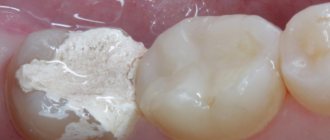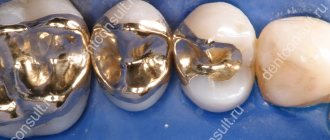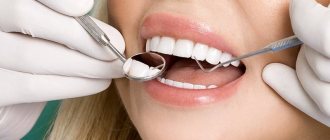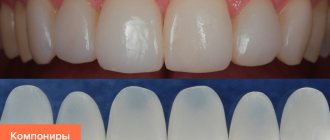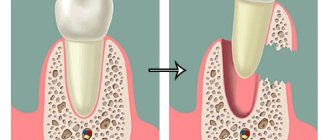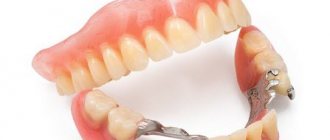Have you had to replace old fillings installed several years ago? Do you know what this threatens?
We will tell you how to avoid frequent replacement of fillings by using another dental restoration technology. In the article Filling, inlay or crown? We reviewed different methods of dental restoration, and today we will tell you in detail about the advantages of inlays .
An inlay is a filling made in a dental laboratory from filling materials, metals or ceramics.
Restoring a tooth with an inlay is more expensive than with a regular filling, and to understand whether it’s worth paying more , let’s figure out why an inlay is better than a filling. The benefits of inlays become obvious if you understand the reasons for replacing old fillings.
Let's start with the functions that the filling performs.
Material shrinkage is one of the reasons for replacing old fillings
Protection of the tooth from infection is ensured by the tightness of the connection at the border of the filling with the tooth tissue. Modern adhesive compounds reliably glue the filling to the tooth, but sometimes this can become a problem.
During curing, any material decreases in volume ( shrinks ) and filling material is no exception. By shrinking, the filling “pulls” on itself the parts of the tooth to which it is securely glued, and if the area of the filling is large, this force may be enough to cause cracks and chips to appear.
secondary caries forms at the site where the filling is torn from the tooth tissue .
Shrinkage of the filling material also poses other problems:
- with vertical shrinkage, the height of the bite changes, which leads to dysfunction of the temporomandibular joint and improper load on the filled tooth. As a result, the tooth may become damaged and require a crown to be installed to restore it.
- shrinkage of the filling horizontally leads to the disappearance of the contact point (point of contact) between adjacent teeth and stuck food puts pressure on the periodontal papilla, injuring it. The gums become inflamed, gingivitis, periodontitis and secondary caries develop.
When should you replace old fillings on your teeth?
- The fit of the filling material to the tooth is broken, that is, the tightness of the filling. Thus, a space invisible to the eye is formed, into which microorganisms penetrate, and a plaque remains. This leads to further development of caries and tooth destruction.
- “Hanging” of the filling over the gum or lack of a good contact point between the teeth. This leads to constant clogging of food, resulting in the gums being in a state of chronic inflammation, bleeding and pain. As a result, there is a risk of developing root caries and, as a result, the need for tooth extraction.
- The surface of the filling is heavily worn out. This leads to a decrease in the height of the bite, which can ultimately lead to diseases of the temporomandibular joint (TMJ), when a person begins to feel discomfort in the joint, clicking and crunching, and chronic headaches begin.
- The filling is “flat” and does not restore the natural shape of the tooth. This also leads to TMJ diseases.
- A tooth hurts under an old filling. In this case, immediate intervention by a doctor is required, since, most likely, caries has already developed under the filling.
Old fillings need to be replaced not only because they become unsightly, but above all, to keep teeth and gums healthy and prevent further damage.
If you want to keep your new fillings in excellent functional condition for many years to come, remember that the filling material requires careful polishing. Toothpaste, brush, food scratch the surface layer of the filling, and the aggressive environment of the oral cavity makes its own adjustments - as a result, microcracks and porosity appear. To avoid this, during professional hygiene the doctor carefully polishes all restorations. This not only returns the filling to its former appearance, but also prevents relapse or secondary caries.
In order to understand whether it is necessary to change old fillings on your teeth, to protect your tooth and budget from caries under the filling and its unwanted complications, it is enough to come for an examination to the dentist 2 times a year. Even if absolutely nothing bothers you.
Preventing a disease is much easier than curing it! And if your dentist talks about the need to replace an old filling, agree without hesitation - the doctor will not give bad advice!
Sources used in writing the article:
- “Therapeutic dentistry” (2012), Maksimovsky Yu.M., Mitronin A.V.
- “Dental caries” (2005), Borisenko A.V.
- “Prevention of dental diseases” (2004), T.N. Terekhov., T.V. Popruzhenko.
Please rate this article
Stanislav Mezheritsky
Chief physician, surgeon, orthopedist
The author of the article is Stanislav Mezheritsky, a practicing dentist with 19 years of experience, chief physician and one of the founders of the Matisse Dent clinic. The main focus is orthopedic and surgical dentistry. Author of numerous publications, regular participant in specialized seminars.
What are the consequences of insufficient filling strength?
The technology for making a filling (in the patient’s mouth) does not make it as strong as possible, so over time the filling material wears out.
As in the case of vertical shrinkage, abrasion of the filling can lead to problems:
- the level of bite changes , and this can lead to the chipping of part of the tooth due to the redistribution of the chewing load from the filling to the walls of the tooth.
- the boundary between the filling and the tooth tissue changes , while the filling loses its tightness and the infection penetrating inside provokes the development of secondary caries.
How often does the filling need to be changed?
It cannot be said that the filling has a specific service life, after which it must be replaced, but you need to regularly visit a dentist who, when the first signs of caries appear under the filling, will be able to carry out the necessary treatment and replace the filling.
Nowadays, almost every person has fillings on their teeth. All of them are of different quality, made of different materials. Indeed, there are a large number of materials from which fillings are made, but the most popular are photocomposites, which have high aesthetic and strength characteristics. And their use allows you to make dental treatment quite durable.
The service life of such a filling depends on a number of factors:
- Size, size of the defect - the larger the carious lesion, the less durable the filling will be.
- Condition of hard dental tissues
- The qualifications of the doctor - an experienced doctor, who also performs dental treatment under a microscope, will, of course, place a more durable filling, because it will ensure a tight fit of the material to the tooth tissues.
- High-quality tooth treatment, removal of all carious tissues - you need to be sure that absolutely all carious tissues have been removed; this is why treatment of caries under a microscope is recommended.
- Compliance with all stages of the protocol, mastery of recovery techniques.
- And, of course, careful treatment of teeth - despite the fact that there seems to be no special care for teeth with fillings, high-quality daily hygiene using floss and irrigator, which allows you to remove plaque even in hard-to-reach places, and professional dental hygiene are extremely important mouth
As a rule, a person consults a doctor when something is already bothering him. Basically, it is believed that it does not hurt and does not need to be treated. Unfortunately, caries can develop asymptomatically on teeth that already have a filling, and lead to various kinds of complications. All this happens due to poor quality of previous treatment.
But the doctor will be able to detect the carious process under the installed filling in time. Alarm signals will be a change in the color of the tooth under the filling, staining along the edge of the filling due to a broken marginal fit, the appearance of a “gap” between the filling and the walls of the tooth. X-ray examination or CT scan will help confirm the presence of caries.
It cannot be said that the filling has a specific service life, after which it must be replaced, but you need to regularly visit a dentist who, when the first signs of caries appear under the filling, will be able to carry out the necessary treatment and replace the filling.
Return to list of articles
Other disadvantages of the filling and reasons for replacing it
- Inaccurate anatomical shape of the tooth.
Restoring the correct shape of a tooth in a patient’s mouth is a difficult task. This work requires the dental therapist to have a good knowledge of anatomy and the skill of a sculptor. But even with these skills, it is difficult to model the shape of a tooth in hard-to-reach places.Inaccurate tooth shape is the cause of malocclusion (especially if there are a lot of fillings). Teeth grind food incorrectly, causing discomfort when biting, headaches appear, teeth are injured in the process of chewing food and are destroyed over time.
- Overhanging edges of the filling.
If, when installing a filling, the material flows onto the gum and rests on it, this leads to permanent injury and inflammation of the gums.A filling installed with such a defect causes local periodontitis and secondary caries, since it is difficult to remove stuck food from the resulting “pocket.”
- Difficulty in thoroughly sanding surfaces .
In places of contact with neighboring teeth, it is impossible to completely get rid of the roughness of the filling, and dental plaque adheres well to such a surface. - Development of caries at the interface between tooth and filling . The gradual shrinkage of the filling material and the destruction of the adhesive connection makes the border between the tooth and the filling the most vulnerable place where secondary caries develops first.
- Changes in the color of the filling material and tooth tissue over time make the border of the filling too noticeable.
When is a refilling required?
To determine when a filling needs to be replaced, you should contact your dentist. He will conduct a diagnosis, including x-rays, and, if necessary, carry out a replacement.
Indications for refilling are the following conditions:
- pain in a filled tooth,
- crown destruction,
- detection of caries under filling material,
- feeling of an unpleasant taste,
- decreased aesthetics of the restoration,
- expiration of the seal's service life.
The most common situations in which refilling is required are discussed below.
Changing Hue
Yellowness, darkening and other color changes in the filling (and enamel) most often indicate the presence of a destructive process in the tooth. If there is a reddish tint, it means that the previously installed material contains resorcinol - in this case, not only a refilling is required, but also additional cleaning of the canals, as well as an internal bleaching procedure.
Abrasion of the filling mass
Over time, the fillings wear out, which leads to disruption of the distribution of chewing load. As a result, the bite changes, the load on the temporomandibular joint increases, TMJ pathologies develop, and digestive problems arise.
Overhanging filling
If installed incorrectly, the filling material may “hang” over the adjacent tooth or gum. The accumulation of food particles and impaired contact between units of the dentition provoke an inflammatory process in soft tissues, the proliferation of microorganisms and the development of caries, and bleeding gums.
Subsidence of the filling mass
Shrinkage is typical for any materials used for filling. If it occurs along the axis of the tooth, a person’s bite may change, which will lead to problems with the TMJ and digestion. In addition, vertical subsidence provokes the appearance of cracks and even chips in the tooth, since, as the filling contracts, it “pulls” the hard tissues along with it. When subsidence occurs in the horizontal plane, the degree of contact between adjacent units changes, food debris gets stuck in the interdental spaces, the formation of caries and gum inflammation are observed.
Flat filling surface
If, when filling, the dentist did not pay due attention to the chewing surface, but made it flat, disruption of the chewing process will gradually lead to the development of problems with the gastrointestinal tract. Normally, there are cusps and fissures on it, which ensures full contact with the opposite teeth of the other jaw.
Roughness has appeared
The rough surface of the filling indicates the presence of pores and microscopic cracks in it. This means that microbes have already penetrated into it. Often, when the filling material is removed in such cases, caries is revealed underneath it.
Expired service life
Even if the filling was installed more than 10-15 years ago and still holds, it does not mean that it is fulfilling its function. In the vast majority of cases, when refilling such “rarities”, an extensive carious process is determined.
Unaesthetic appearance
Refilling may be required if the previously installed filling stands out in shade from the background of the remaining teeth. Most often, the situation occurs after the whitening procedure. Over the period of operation, old compounds have absorbed various coloring substances, so to restore the aesthetic appearance (especially of the front units), they need to be replaced.
What does replacing a filling lead to?
What's wrong with changing the filling when needed? The problem is that you don’t know the exact time when the old filling stops performing its functions, but if part of the tooth breaks off, the doctor will be forced to put in a new, larger filling.
In the case of advanced caries and pulpitis, it may be necessary to remove the nerve, but a “dead” tooth is more fragile and fillings and inlays adhere less well to its tissues (which means the service life will be shorter).
We devoted the article Karis to the treatment of different stages of caries: what is it like? And why does treatment differ so much in price? Read it to understand how caries progresses.
With each filling replacement, the “native” tooth becomes smaller and the moment approaches when it can only be restored with a crown.
How do we do this?
Our specialists will painlessly, efficiently and reliably carry out re-filling. The doctor will select the color and model the shape of the new filling. Filling materials are like paints in an artist’s palette: they can be selected individually for a specific case, for each person, and the color, brightness and transparency of the tooth can be very carefully adjusted. Filling occurs in layers, taking into account the anatomical features of the tooth. As a result, the work of a dentist is not noticeable to others.
Nowadays, the latest filling materials are widely used for dental treatment, which help to cope with several tasks at once - therapeutic, aesthetic and preventive. Their number is growing from year to year, and the quality is improving, which allows us to do better and better work.
However, remember, dear patients, that not in all cases you can limit yourself to replacing the filling. If the destruction process is too advanced, you will be offered a ceramic orthopedic inlay or crown instead of a filling. These materials are more reliable and durable, and will help extend the life of your tooth for a long time. In any case, after a preliminary consultation, our specialists will be able to choose the best option for you.
Why is a ceramic inlay better than a regular filling?
Unlike a filling, which a doctor makes in the mouth, an inlay goes through all stages of manufacturing in a dental laboratory. The dentist only processes the tooth cavity under the inlay and makes impressions of the jaws, and after making the inlay, glues it in place.
Restoring a tooth with an inlay requires two visits to the dentist, but ensures long-term functionality and aesthetic perfection of the restoration.
Advantages of ceramic inlays:
- Inlays do not shrink after placement because this process is completed during the manufacturing stage in the dental laboratory.
- Ceramic inlays have the highest strength and do not wear out over time, thanks to production technology. The inlay is pressed from a ceramic mass heated to high temperatures or machined from a single piece of ceramic.
- Inlays completely restore the anatomical shape of the tooth and chewing functions, thanks to the modeling of the bite in the articulator using casts of two jaws.
- Making an inlay with fitting on a plaster model makes it possible to create it without overhanging edges , restore tooth defects in hard-to-reach places, ensure correct interdental contact and good marginal fit of the inlay to the tooth. All this is difficult to do when making a filling in the oral cavity.
- All outer surfaces of the inlay (including those in contact with adjacent teeth) are perfectly ground before installation.
- It is easier to select the desired color and translucency of the inlay in the laboratory than in the patient’s mouth. Therefore, ceramic inlays are the best option for aesthetic dental restoration.
- The inlay is more reliably glued to the tooth, since the doctor requires a minimum of time to install an inlay of exactly the right size into the treated tooth cavity (due to the speed of installation, the risk of moisture and infection on the treated surfaces is reduced).
By restoring a tooth with a ceramic inlay, you get a high-quality, durable restoration and do not get tired during the appointment, since you do not need to sit for a long time with your mouth open.
For medical reasons, if the coronal part of the tooth is destroyed by more than 30%, it is recommended to install an inlay.
What types of fillings are there?
Today, various materials are used to fill teeth. The most widespread are the following:
- cement: it is cheap, therefore it is actively used in the budget dental field. Fillings made from this material are susceptible to destruction, short-lived (maximum - 1-2 years), when replacing them, doctors often diagnose a carious process,
- amalgam: based on mercury, copper and silver. They are characterized by high strength, but the appearance leaves much to be desired. In addition, mercury is a toxic substance,
- <>photopolymers: the most modern option. They harden in the light, are durable, highly aesthetic and natural in appearance. On average, they last about five years,
- chemically cured composites: the material cures on its own, without exposure to a blue light lamp (but can still be used to speed up the process). A very durable composition, most often applied to chewing areas - premolars and molars. Aesthetics worse than photopolymers,
- glass ionomer cements: differ from classical cements in a large number of advantages, because They last a long time, the price is not too high, they are low allergenic and can be installed for children.
Types of ceramic inlays
- inlay tab - restores the “cavities” of the tooth crown
- onlay tab - restores most of the chewing surface of the tooth crown
- overlay tab - restores the chewing surface and side walls of the tooth crown
The service life of the inlays is more than 10 years, while the filling will require replacement after an average of 5 years.
Now, when a dentist suggests restoring a tooth with an inlay, you know what benefits this will provide in the future.
